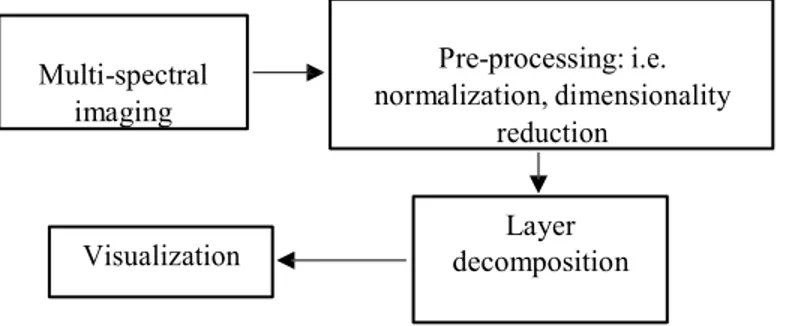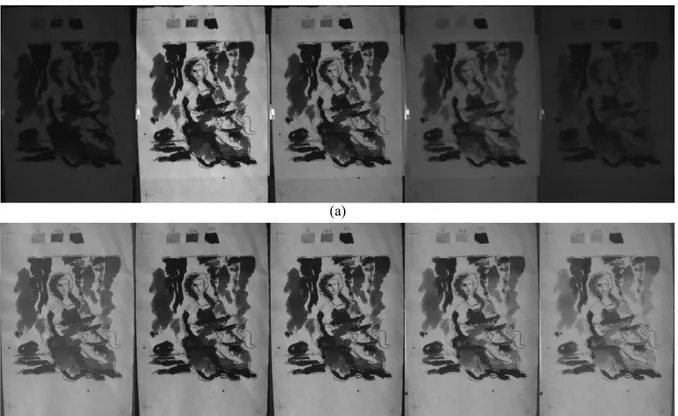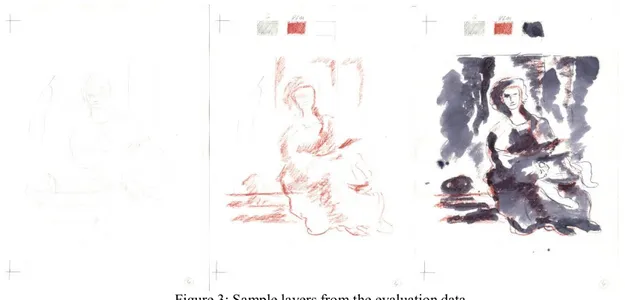Sketch Layer Separation in Multi-Spectral Historical
Document Images
AmirAbbas Davari
1, Armin Häberle
2, Christian Riess
11. Pattern Recognition Lab, Computer science Department,
Friedrich-Alexander Universität Erlangen-Nürnberg, Erlangen, Germany
[amir.davari, christian.riess]@fau.de
2. Bibliotheca Hertziana - Max-Planck-Institut für Kunstgeschichte, Rome, Italy
Haeberle@biblhertz.it
MOTIVATION
Recently, the progress in computer science made links between this field and art history possible. The examination of cultural artifacts particularly gained new insights in materials and object structure from new possibilities in high-resolution image acquisition and data processing. However, although there is a large number of specialized examination methods (for example IR/UV reflectography, fluorescence, micro-XRF, Raman spectroscopy), the research on hand drawings still suffers from major diagnostic gaps: due to the particular properties of red chalk, it is currently not possible to visualize preparatory drawings from red chalk if they have been overlaid by inks.
Up until the end of the 19th century, hand drawings were typically created with different materials in several working steps. In the final drawing, multiple layers of different materials overlap, such that the lower, older layers can oftentimes not be identified visually. However, these layers represent the various steps of the genesis of the respective work. Thus, separating these layers by means of imaging and image processing promises a direct look into the artistic creation process of the work. Therefore, such a technical approach may supply answers to key
questions of art history on the object and the artist, and may help for objectivation of attribution and authenticity. In this work, we investigate an approach to close this diagnostic gap. In contrast to image acquisitions with a limited spectral window (like infrared or ultraviolet light), we propose to image an object using a multispectral camera, and to process the acquired data with methods from the field of pattern recognition. A multispectral camera operates primarily in the range of visible light, but subdivides the light into much more channels than red, green, and blue. This allows to differentiate materials of different physical compositions from their reflection patterns after processing the data with a computational algorithm. We evaluate the proposed method on drawings that were created to exactly mimic the original work process, using the same materials and papers. The controlled creation process provides knowledge about the drawing layers, which allows to assess the accuracy of the method. This approach has the potential to avoid radiation damage to the work of art under examination, while still being able to provide meaningful information. Thus, it appears as a method that can have broad applications in the domain of art history and conservation of art, that extend beyond the range of currently used approaches (Cosentino, 2014) (Pronti, 2015).
WORKFLOW
The proposed workflow for analyzing drawings is shown in Figure 1, and explained in several steps below.
Multi-spectral imaging
Pre-processing: i.e. normalization, dimensionality
reduction
Visualization decompositionLayer Figure 1: Proposed workflow Color Channel Normalization
The sensitivity of the multispectral sensor varies across the captured spectrum. As a result, different channels exhibit varying brightness, which makes analysis of the images more difficult. To avoid these brightness differences, we capture an image of a homogeneous white surface before scanning the drawing. In the scan of the
drawing, each channel is corrected with a multiplicative factor, such that the sensor response on the white surface is homogeneous; Figure 2.
(a)
(b)
Figure 2: Five sample spectral channels of a 258-band multispectral image. Images from left to right correspond to channels 31, 76, 100, 173 and 205 respectively. a) Before normalization b) After normalization. Dimensionality Reduction on the Spectral Bands
The 1040 spectral bands make it challenging to analyze the multispectral image directly. Therefore, a common approach in other communities working with multispectral images is to greatly reduce the dimensionality before further processing (Harsanyi, 1994). During dimensionality reduction, most of the spectral bands are either discarded (because they are found to be non-informative) or summarized using a linear or non-linear mapping function.
Principle component analysis (PCA), introduced in (Hotelling, 1933), is probably the most popular tool for this task. We first average every four neighbored channels, which reduces the dimensionality to 258, and then use PCA to summarize this information in only 5 channels (mathematically, this corresponds to preserving 99.5% of the image spectrum variance on our data). The representation of the image information in such a much lower number of channels makes the subsequent processing step more robust.
Clustering
Drawing regions of identical chalk or ink show a similar reflectance behavior. To group image po ints of similar reflectance, we experimented with clustering algorithms. Specifically, we compared the performance of the K- means algorithm (Lloyd, 1982) and Gaussian mixture models (GMM) (Friedman, 1997). In both cases, we expect that each chalk or ink is sorted into an individual cluster.
EXPERIMENTAL SETUP, RESULTS AND EVALUATION
Data
We created a set of sketches with multiple layers of chalk and ink. We used papers and inks/chalks of the same chemical composition as it was commonly used in ancient drawings. After drawing each layer, the picture has been scanned with a standard flatbed scanner. This allows to compute the true layer composition for evaluating the layer separation algorithm by subtracting two subsequent scanned images. A sample sketch from this data is shown in Figure 3.
Figure 3: Sample layers from the evaluation data
For imaging, we use a multi-spectral camera equipped with a CMOS sensor, capable of capturing the spectrum in a wavelength range of 400nm to 1000nm, subdivided into 1040 so-called spectral bands.
Evaluation
For the evaluation of the data, we first compute the layer separation on the multispectral data. Then, we compare the result of this computation to the individual (known) layers from the data creation process. A result image is shown in Figure 4 (computed on the input data in Figure 3). On the left, the separation result of the K-means algorithm is shown, on the right the result for GMM clustering. Identical grayscale values indicate identical cluster membership. K-means grouped the background into two clusters (most likely due to inhomogeneous illumination), while GMM isolated the background into a single cluster. It also turned out that GMM performed better in separating diluted inks, which can be best seen in the top right of the sitting person in the picture. Thus, we tentatively conclude that GMM might be a better suited method for isolating sketch layers.
In future work, we aim to expand this study to a larger dataset, and also to quantitatively evaluate the performance of sketch layer separation. For quantitative evaluation, it is important to map the multispectral picture pixel by pixel to the known layers, which can be achieved by using an image registration algorithm.
K-means result GMM result
REFERENCES
Figure 4: Clustering results
Cosentino, A. (2014). Identification of pigments by multispectral imaging; a flowchart method. Heritage Science, 2(1), 1.
Friedman, N., & Russell, S. (1997, August). Image segmentation in video sequences: A probabilistic approach. In Proceedings of the Thirteenth conference on Uncertainty in artificial intelligence (pp. 175-181). Morgan Kaufmann Publishers Inc.
Harsanyi, J. C., & Chang, C. I. (1994). Hyperspectral image classification and dimensionality reduction: an orthogonal subspace projection approach. IEEE Transactions on geoscience and remote sensing, 32(4), 779-785.
Hotelling, H. (1933). Analysis of a complex of statistical variables into principal components. Journal of
educational psychology, 24(6), 417.
Lloyd, S. (1982). Least squares quantization in PCM. IEEE transactions on information theory, 28(2), 129-137. Pronti, L., Ferrara, P., Uccheddu, F., Pelagotti, A., & Piva, A. (2015, November). Identification of pictorial
materials by means of optimized multispectral reflectance image processing. In Information Forensics and Security (WIFS), 2015 IEEE International Workshop on (pp. 1-6). IEEE.


